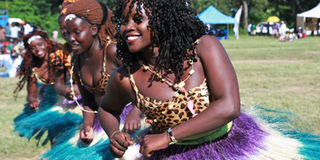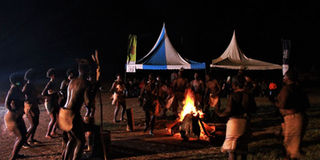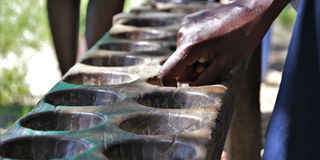Premium
Pomp and colour at 8th Rusinga Cultural Festival

Dancers entertaining guests with a cultural performance at the 8th Rusinga Cultural Festival. PHOTO | MESHACK YOBBY
What you need to know:
- The Abasuba people have long been mistaken as part of the Luo community when in fact, they are a Bantu people
- The first day of this year’s festival saw an excursion to Ruma National park, the last retreat of the roan antelope
- The Abasuba dance was also to be launched at the event
Every year, on the last Thursday and Friday before Christmas, people from all over the country and the neighbouring Uganda flock Mbita in Homa Bay County for the Rusinga Island Festival.
The festival draws such huge crowds that it becomes nearly impossible to find accommodation and some choose to camp.
On the 19th and 20th of December 2019, the festival held its 8th edition at Kamasengre grounds.
The theme for this year was “The Island Remembers”, designed to give the Abasuba people a reason to reminisce, re-imagine and connect Rusinga Island to the world through art, culture, literature and heritage.
GOOD OLD CULTURE
“It was sort of a trip down memory where we wanted to remember the good old culture of the Abasuba. Other than that, 2019 was a momentous year for the Island in that we were also commemorating the fifty years that had passed since the death of the island’s greatest son - Tom Mboya – through an assassin’s bullet,” festival organiser Anne Eboso said.
The Abasuba people have long been mistaken as part of the Luo community when in fact, they are a Bantu people.
Their migration to the Lake Victoria islands of Rusinga and Mfangano begins with a period of conflict in Buganda Kingdom. As it is with tales passed from one mouth to another, each time shedding a bit of flesh here and gaining wings there, the accounts of the cause of conflict are different.
The only point of convergence is there was a death in the kingdom that would one day have an effect on the islands of Lake Victoria.
One account says that the death was, in the first place, caused because Kabaka Jjunju cast his eyes on a young woman so beautiful that he spent his waking hours dreaming of her.
He was the Kabaka, a man of power and means, ruler over a fierce army of warriors and a much feared man. Maybe it hit him one night that he was the Kabaka; he could get anything he wanted in his kingdom. Or any woman.
When the young woman was sent to deliver a gift of maize to the palace, Kabaka Jjunju said he wanted to sleep wither. She refused, saying she was pregnant with someone else's child. The Kabaka, not accustomed to disobedience, ordered his men to open her belly to find out the sex of the baby inside. The young woman did not survive.
The problem was, this woman was Prince Ssemakookiro’s wife. Ssemakookiro was Kabaka Jjunju’s own brother.
Knowing that there was trouble brewing, Kabaka Jjunju sent his brother to live in the forest. Outraged, Prince Ssemakookiro recruited soldiers ordered his men to rebel and overthrow Kabaka Jjunju. He put his trusted warrior Witewe of the Abakunta in charge of a regiment and sent them off.
Spears and arrows ruled the skies of Kiwawa in a tough battle and in the end, Kabaka Jjunju was defeated. One warrior, Kiboye, perhaps in excitement, chopped off the dead Kabaka’s genitals.
Perhaps this disrespect was too much for Ssemakookiro, or perhaps he wanted to make sure there was no other force in the land capable of attacking him. Ssemakookiro ordered the arrest of the Abakunta.
The Abakunta warriors and their families fled Buganda, rowed across Lake Victoria and set up camp on two islands where they would see the enemy approach early enough. Thus, from the death of one beautiful woman far away, an entire tribe came from to occupy Rusinga and Mfangano islands, and parts of mainland Mbita.
ASSIMILATED
Many generations later, the Abasuba became so assimilated with the Luo that their language, their culture, slowly began to die. People even forgot that they are Bantu, not Nilotes.
Eight years ago, Anne Eboso started the festival because most of the Abasuba she met introduced themselves as Luos.
“The moment I got sons, I felt that I didn't want them to struggle with their identity as well. And as a woman, I felt I could contribute to the promotion of the Suba culture and heritage through the production of a festival,” she said.
“I wanted the festival to also contribute to the socio-economic development of the Abasuba hence why the festival promotes cultural tourism, youth and women empowerment. At that time, there was no event in Rusinga Island that was promoting the Suba culture and heritage.”
The first day of this year’s festival saw an excursion to Ruma National park, the last retreat of the roan antelope.
At the festival grounds, cultural music and dances went on throughout the day. This included the launch of the Abasuba anthem, composed by Ages Kenya, a cultural group based at the Kisumu Museum. The lead composer was Agiva Bwana, the head of the group.
The Abasuba dance was also to be launched at the event. Bomas of Kenya have been working on research and production for the past three years. However, the festival opted to first validate the dance.
The Bomas team, together with a costume designer got the council of elders and community members in a room to validate the dance, pronunciation and costume. Recommendations were made and now there is hope for an actual launch during the next edition of the festival.
The dance, dubbed 'owukire', means victory. It celebrates the Suba culture and tells the migration tale from Uganda to present day Homabay county.
REMINISCENT
In the evening, Goethe Institute organised a book reading by the lake. The featured author this year was Jackson Biko.
At about 8pm, residents were back at Kamasengre grounds for the evening session. Lights were switched off for the fire-lighting ceremony. All over, there were chants and suddenly, a woman with a burning branch ran to the centre of the grounds and set ablaze the pile of wood that lay there.
Thus, Boma Night began. It was a night or music and storytelling around the bonfire. George Chunga was a favourite, even being called back for an encore. As the night deepened, the stories faded, and the islanders danced away.

Boma Night, a night of music and storytelling at the 8th edition of the Rusinga Cultural Festival. PHOTO | MESHACK YOBBY
The second day of the festival began with the much anticipated boat race. Different groups marched from Kamasengre grounds to the already full Luore Beach, where Ambassador Amina Mohamed, the Cabinet Secretary for Sports Culture and Heritage, flagged off the event.
The ability to row boats is not only reminiscent of the escape of the Suba from the Kingdom of Buganda, but also an important part of their livelihood. Fishing is the main economic activity on the island.
Back at Kamasengre grounds, music and dance continued. Cultural foods prepared by Abasuba women were served. At one end of the grounds, a group of elderly men played ajua, the ancient board game.

Ajua, the ancient board game, played by a group of elderly men at the 8th edition of the Rusinga Cultural Festival. PHOTO | MESHACK YOBBY
Late in the afternoon, there were tug of war contests between different groups, as well as wrestling. The final event was a beauty pageant at night.
The event was graced by several leaders, including Dr. Auma Obama, Mbita M.P Millie Odhiambo, Homa Bay woman representative Gladys Wanga, Embakasi M.P Babu Owino and Makadara M.P George Aladwa.




